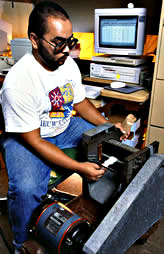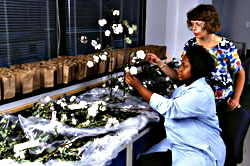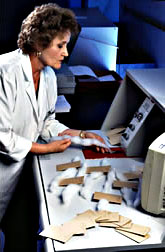Speck Trek Tracks Hard-To-Dye Cotton
 Technician Kevin Pratt collects data on cotton samples and uses a small roller gin to prepare the samples for fiber analysis. (K7508-1) |
Diverse researchers unite to identify source of textile flaw.
What do you get when you put cotton researchers from the U.S. Department of Agriculture together with key contacts from industry, academia, and agriculture?
You get Speck Trek, a multidiscipline, scientific task force focused on reducing fabric dyeing flaws by improving cotton quality.
"Simply put, Speck Trek is the prediction of white specks and other textile processing flaws—from field to fabric," says plant physiologist Judith M. Bradow, who organized the informal collaborative group.
"It lets researchers from diverse fields exchange knowledge on how the environment affects cotton quality," she says. "Much like the television and movie Star Trek crews, we use our diverse backgrounds to solve problems. It's just that our focus is on what growers, ginners, and mills can do when nature doesn't cooperate."
Having more than one kind of researcher address textile dyeing problems makes sense, because poorly dyeing fabric can come from a number of sources. Poor growing conditions, plant disease, and errors in processing may all contribute. And once a fabric has those tell-tale white spots of undyed fiber, it must be discounted or thrown out.
"Textile people must worry about dye imperfections," says Bradow. "At a 1991 conference they listed them as the second most important problem in textiles. But at the time, nobody was looking into the physiological reasons for a fabric not taking up dyes."
Bradow and her colleague, plant physiologist Gayle H. Davidonis, decided to explore the connection between dyeing quality and plant health. The two scientists are stationed at the ARS Southern Regional Research Center in New Orleans, Louisiana. The center is home to several textile and fiber laboratories, including the Cotton Fiber Quality Research Unit.
Cotton brought $482 million to Louisiana's economy in 1995. That made it the state's top-earning crop by USDA estimates. The entire U.S. domestic cotton crop—fiber and seed—was valued at over $55 billion.
But cotton plants are not in it for the money—they only want to reproduce. Their fruit, known as the boll, contains the fiber and seed. Researchers speculate the plants first produced fiber to scatter seed, either by wind or by hitching rides on passing animals.
But self-preservation takes over when it comes to bad growing conditions. The plant may allow only a few bolls—or even seeds—to ripen and mature fully. Just a single dry day can cause problems, for without water, the plant doesn't produce the carbohydrates needed to fill the fiber walls with cellulose required for dyeing. Electron microscopy done by other researchers at New Orleans demonstrated this problem.
When Bradow decided to explore what growers could do to counter nature's ill effects, she needed more than the greenhouses at the center. So she joined forces with agronomist Philip J. Bauer in the ARS Cotton Production Research Unit at Florence, South Carolina, who had plenty of test fields.
 Plant physiologist Gayle Davidonis (right) and biological science aide Deborah Wilson discuss plant mapping and its contribution to understanding differences in cotton fiber quality. (K7507-1) |
When storms from Hurricane Andrew drenched Bauer's cotton crop in 1992, he sent Bradow boll samples. Together, they analyzed how cloudy days and excess rain had damaged fiber quality. They continue to research the effects of irrigation and temperature on cotton and are to be joined by a university soil scientist who can expand their work.
Soon other researchers were also sending boll and fiber samples to either Bradow or to her partner, depending on their experiments' requirements. While both analyze fiber, Davidonis specializes in fiber development and seed quality, and Bradow's expertise is in boll maturity.
Having these scientific contacts puts Bradow and Davidonis in a position to link people with resources. Speck Trek reaches a worldwide audience and Bradow says she expects more farmers and crop consultants will be participating in research projects, helping scientists develop real-world cotton-growing databases that can become part of computer models.
"We have software to help growers enhance yield, and we have software to help textile mills make fabric," Davidonis explains. "What we don't have yet is the bridge between them. Our databases will be the building blocks for that bridge."
Another original member of the team, biochemist Gretchen F. Sassenrath-Cole, became a trekker soon after she joined the ARS Crop Simulation Research Unit at Mississippi State University. Her first interest was to find out how much energy cotton plants needed to produce flowers and grow bolls. But she couldn’t check fiber quality until the bolls completely formed, which stymied her research.
Through Bradow, Sassenrath-Cole gained access to an AFIS (Advanced Fiber Information System) that can track developmental stages of fiber.
"It was really exciting the first time we ran some of the immature fiber samples through," she says. "The bolls were only 24 days past floral anthesis, which is less than halfway through the normal boll growth period. In the few minutes it took to run the sample through AFIS, we had all the information on fiber length, degree of cell wall development, shape, and maturity."
Now Sassenrath-Cole is researching the ways that environment affects fiber quality. To explore this, she will rely on fiber analysis from Bradow.
"Previously, other researchers found fiber walls that looked like annual rings you see on trees trunks. The cotton fiber’s cell wall would be thick in some places and thin in others, and the rings would be more pronounced with cooler night temperatures,” says Sassenrath-Cole. “We want to see if we can identify similar changes under field growth conditions.”
Sassenrath-Cole will also be looking at the role leaves play in maintaining an optimal growth temperature. Some cotton varieties have smaller leaves, which may result in greater temperature variations within the crop canopy.
 AFIS (Advanced Fiber Information System) will automatically determine many quality factors of cotton samples being inserted by technician Katherine Pusateri. (K7509-1) |
Speck Trek also connected Sassenrath-Cole and Bradow with biochemist Allen K. Murray of Glycozyme, Inc., in Irvine, California. Their research helped him explore cotton fiber and leaf biochemistry.
"What Gretchen provided me was fully documented developmental stages of cotton," says Murray. "I had already done work linking water, plant metabolism, and fiber development. But without actual boll samples at 21, 28, 42, and 56 days, I couldn't demonstrate that the big changes were happening with sugars in the plant."
He says that the samples came with an extensive fiber analysis from Bradow, making for consistency and thoroughness.
"It's this unique treatment of the same sample in three laboratories that is so unusual—and outstanding," says Murray. Through this cooperation, he also got results suggesting there are two genetic markers for sugar that occur mainly in drought stress.
"They actually appear before the plant shows any outward signs of drought stress and offer the possibility of an early-warning system for growers," says Murray. "I had documented differences between irrigated and drought-stressed cotton in California, but I had no way to correlate the differences until I received Gretchen’s developmental samples of normal and temperature-stressed bolls.”
“We also benefit from Murray’s impressive research facility and extensive biochemistry knowledge,” says Bradow. “It’s all part of the Speck Trek mission. We build opportunities through cooperation.” — By Jill Lee, ARS.
Gayle Davidonis is in the USDA-ARS Cotton Structure and Quality Research Unit, Southern Regional Research Center, 1100 Robert E. Lee Blvd., New Orleans, LA 70124; phone (504) 286-4273 ext. 273.
Philip J. Bauer is in the USDA ARS Coastal Plains, Soil, Water and Plant Research Center, 2611 W. Lucas St., Florence, SC 29501; phone (843) 669-5203 ext. 7250.
Gretchen F. Sassenrath-Cole is in the USDA-ARS Application and Production Technology Research Unit, P.O. Box 5367, Mississippi State, MS 39762-5367; phone (662) 686-5289
"Speck Trek Tracks Hard-To-Dye Cotton" was published in the December 1996 issue of Agricultural Research magazine.






